Though the turn-based JRPG genre is far from dead, you’ll be hard-pressed to find someone who is able to give you list of ten stellar titles of the genre from the past decade. Doubly so if such a list would comprise of only larger non-indie releases.
Tastes change, and the market changes with them. As the market shifted to FPS games in the Xbox 360/PlayStation 3 era, the demand for turn-based titles seemed to be at an all-time low. For myself — and many others at the time — it seemed like JRPGs wouldn’t be able to recuperate.
In the genre’s heyday, Square Enix (then two separate companies: Squaresoft and Enix) ran amok with creative RPG titles. You had well-known series like Final Fantasy, Dragon Quest, Chrono, and Mana; as well as some lesser-known but still relevant games like SaGa Frontier, Star Ocean: The Second Story, Grandia, and Valkyrie Profile.
The list of titles fans could pick up between the Super Nintendo and PlayStation 2/Game Boy Advance era is nearly as varied as it is extensive. The Final Fantasy series is best known for each game being as different as night and day outside of the battle and exploration elements, but it seemed every series was trying something new with each iteration at the time. And if they didn’t, there was another great game with new bells and whistles sitting at your local game shop to pick up and play to keep things interesting.
I mention all of this now because Octopath Traveler seems a remnant from that time, rather than a product from the current market. Steps the genre took forward, for better or for worse, have been reversed in this time capsule of a game in ways that I thought Japanese developers had simply given up on in the quest to satisfy the almighty otaku and its endless spending budget.
Fans of the SaGa series, particularly SaGa Frontier for the PlayStation or Romancing SaGa: Minstrel Song on the PlayStation 2, will find much to love in Octopath Traveler. Though this game was promoted as being similar to Final Fantasy VI and the like, Octopath takes several pages out of the SaGa series and binds them into its own book to make for a more approachable variation of virtues SaGa has clung so heavily to over the decades.
How a game like this can break out onto the market and make waves in 2018 is a wonder, but I’m not one to look a gift horse in the mouth.
The virtues of the Octopath
There’s no reason to draw comparisons between SaGa and Octopath Traveler throughout this whole review. There is a need to go past the shining virtue they both share: freedom.
One of the first things you’re going to realize after you finish your first story mission is that Octopath Traveler gives you virtually no guidance. You’ll get some short tutorial screens covering most of the game’s mechanics, and you can see where the other party members are located as well as your next story destination but the game doesn’t tell you much more than that. It sets you loose and tells you to have fun. I have to tell you, as a 20-year SaGa fan, the freedom granted absolutely tickled me.
Being given no guidance on where smaller dungeons or objectives are is only one part of the openness the player can experience here.
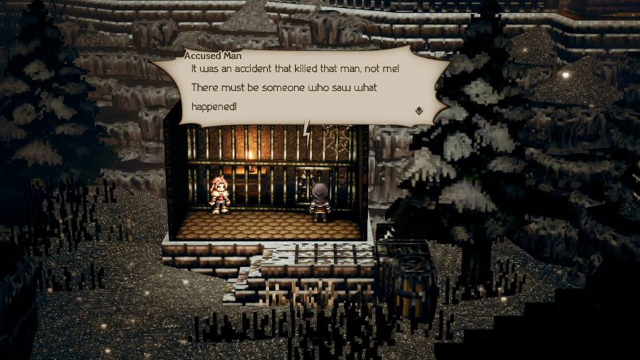
Each character is able to perform Path Actions, which allow them to interact with NPCs in town. Path Actions are generally used to get items off of NPCs, move them out of the way, or find out more about them but they are not that cut-and-dry.
There are technically only four different types of Path Actions, with each type having two variations. For example, both Alfyn the apothecary and Cyrus the scholar are able to extract the same information from NPCs. The difference is Alfyn’s Analyze will always succeed, while Cyrus’s Scrutinize may fail and reduce your reputation in the town the NPC is located in.
This trend continues with the other characters. Both Olberic and H’aanit can fight NPCs in town, but Olberic fights alone via Duel and will not lose reputation on loss. H’aanit fights using only her captured animals via Provoke and, upon loss, will lose reputation in town if you lose.
This system allows for a couple of things, the first being the ability to essentially ransack a town, and the other being Octopath‘s side quest system.
Like the SaGa series (I’m sorry, I just can’t help but compare), side quests are noted in your journal to keep track but the solution to these issues is almost never obvious. A fisherman’s complaining about the lack of fish in the local river, what do you do? There seems to be a guy out in the field catching the fish the reach town, but telling the other NPC won’t help. You have to beat the illicit fisherman up via Duel or Provoke to teach him a lesson about sharing.
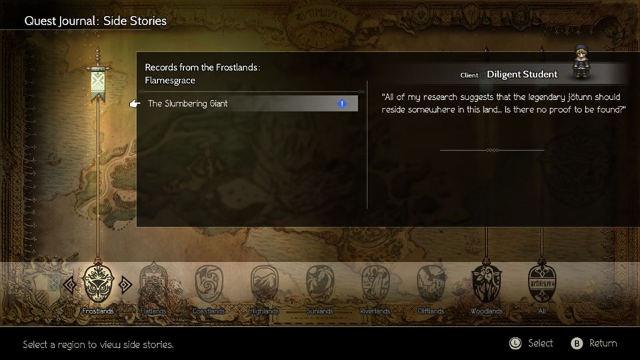 This is about the amount of information you have when setting out on a new side quest.
This is about the amount of information you have when setting out on a new side quest.
These sorts of quests are found all throughout the game, from the first chapter all the way to the end. Much of your time chasing side quest objectives ends up boiling down to talking to NPCs in town, Analyzing or Scrutinizing them, and reading the text to get hints about what to do. Sometimes a side quest’s relevant NPC is all the way on the other side of the world. Once you figure it out, it’s up to you to take the time to complete the quest or not. It’s easy to imagine non-completionists ignoring side quests that are particularly troublesome. There are several potential steps to finish any given side quest.
The ability to traverse and explore the world on your own terms is a rare one among Japanese RPGs, particularly today. Fortunately that’s not the only throwback worth mentioning in Octopath Traveler‘s array of classic mechanics. The game also features a class system reminiscent of certain older RPGs to allow for party and gameplay flexibility, something that’s fun in both function and thought. It also features a battle system that some older RPGs would have died for.
Turn-based goodness and random battles galore
You just can’t talk about a game like this without bringing up the battle system, particularly since you end up spending so much time in battle.
There are two things to specifically note about the battle system here: much of combat boils down to weakness exploitation, and the default encounter rate is high.
You spend a great deal of your time in combat in Octopath Traveler due to both of those factors. You will rarely do heavy damage to enemies without breaking their guard, and the high encounter rate means you’ll be running into them every few seconds when exploring.
This is something I have a hard time finding fault with, even if I want to try. I find myself thinking about skill usage regularly because the game demands you exploit their weaknesses to thrive, which makes frequent random battles fun more than frustrating — though it would be disingenuous to say that sometimes the high encounter rate is not frustrating. Sometimes, when you’re just trying to get a chest on a side path and want to keep moving, it truly is.
You can curb the high encounter rate using the Evasive Maneuvers special skill, which you’ll get first on Cyrus. Evasive Maneuvers is great when exploring areas where the enemies are weaker than you are but can be a real detriment when you are exploring the unknown and need the EXP from battle. I recommend using it sparingly.
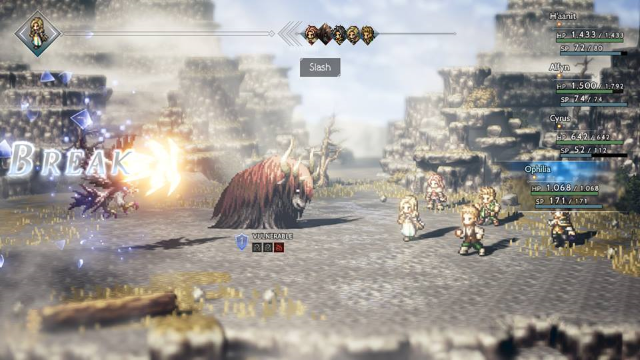
Your party characters play very differently from each other in battle, which is a boon to the combat system. H’aanit can capture monsters and use them as skills in-battle, Tressa can hire mercenaries to swoop in and wail on your enemies with a strong attack, Alfyn can concoct restorative and elemental-exploitative skills in battle by consuming herbs; the list goes on.
The variety in gameplay options between each character keeps battles interesting. Though often the solution to easier battles is to let Cyrus or whoever you are using with the scholar subjob nuke enemies into dust, more often than not each battle will be a little different depending on what you have available and enemy weaknesses.
Along with all of the above is the use of BP, or Boost Points. Each character starts a battle with one BP and accumulates one more (up to a maximum of five) each turn. You can choose to consume up to three of a character’s BP to increase the effectiveness of the skill they’re using that turn. If you use it on a damage skill, it will increase the amount of damage it does. If you use it on a restorative skill, it will increase its effectiveness. If you use your BP on a regular attack, that character will attack multiple times within a turn.
There are a lot of good things to say about the battle system in Octopath Traveler, and the Boost Point system is probably one of the best aspects. It’s great that each character has its own unique skills in combat, but the ability to break an enemy’s guard and then just tear them to shreds with some BP-enhanced attacks is extremely satisfying at times and adds a whole other layer to combat as a whole. You have no choice but to learn to use your BP to your benefit.
Considering the amount of time you have to spend in battle, it rarely gets boring outside of those times when you really just don’t want to fight anything. Though I do have to admit, I’ve made at least one comment about the encounter rate approaching Xenogears-levels of incessant.
The classic look done modern
I knocked the Final Fantasy VI comparison earlier in this review, but there is one way Octopath Traveler does resemble its classic predecessor. Character and enemy sprites do have the sort of detail one might expect from a modern 2D remake of the aforementioned Final Fantasy titan.
The main party character sprites are detailed and lively, and would not look out of place in a PlayStation-era RPG aside from their high-def pixels. The outfits that come with subjobs are the icing on top of a cake that’s already plenty filling.
Enemy sprites are also highly detailed and would fit in right at home with enemy designs of yore, and some bosses… Well, let’s just say you should see them for yourself.
Such attractive sprites would almost be wasted on any other graphical style as they mesh perfectly with the game’s pseudo-3D environments. The game’s environments almost look like pages out of a pixelated popup book. The effect is much more impressive when playing the game yourself than in screenshots or videos, especially if you turn off corner shadows in options.
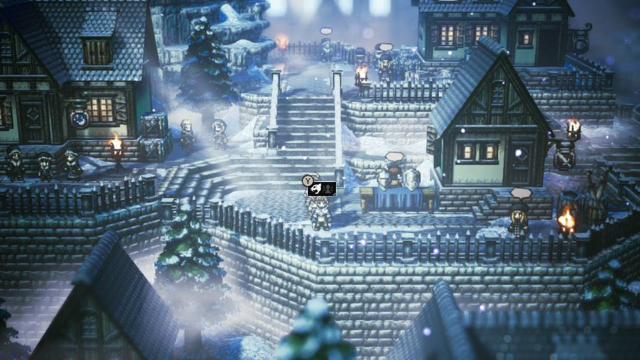
It would be a disservice to the fine people behind the game and especially composer Yasunori Nishiki not to mention Octopath Traveler‘s fantastic soundtrack at this point. As with the visuals, the music is a creative fusion of old and new.
The game’s music is more complex than the RPGs it takes inspiration from, but that doesn’t make the battle themes less memorable nor the town themes less distinct. The soundtrack behind the game stands on its own and is an impressive effort from Nishiki. It would not be a surprise if we see him in the credits for more RPGs in the future. His compositions here are perfectly suitable.
All the praise.. so why a 9?
There are some games you play and you know you will be able to recommend them to everyone you know. I certainly would like to do that, but there’s a caveat that comes with freedom in these sorts of games: an inability to figure out what to do.
This isn’t something I had much trouble with in the game as a long-time SaGa player, but most people haven’t played or even heard of SaGa for a reason. Trying to figure out where to go or what to do can be frustrating, and a lot of people don’t have the patience for that.
Octopath Traveler is easily my favorite Square Enix RPG in years but the fact is these sorts of RPGs are not for everyone. Just because I enjoy stealing from and analyzing every interactive NPC I come across in the hopes of stealing something good or getting a hint about a quest doesn’t mean the gaming populace as a whole will like it. I like messing around in menus, grinding, and getting lost in RPGs. It’s likely you may not.
In addition, the game is not particularly story-focused. There is some party dialogue after story events after chapter 2 (provided you initiate it), but the plot is a big part of the experience for most RPG gamers. It is not an especially large factor in the overall Octopath journey. I found myself not caring about the plot in the least. I just wanted to progress my party and explore, which I did and am still doing with my Switch in sleep mode next to me.
If any combination of facets mentioned here sounds good, you may very well fall in love with Octopath Traveler much the same way I did. It has been so long since I’ve played a completely fresh Japanese RPG with such freedom, that in my case this game is a completely welcome but familiar experience from start to finish. I did not know games like this could still come out of Japan today sans the odd remake. In some ways Octopath Traveler feels like a return to form, and I am very thankful it’s finally come.
[Writer was granted a free copy of the game for review purposes.]

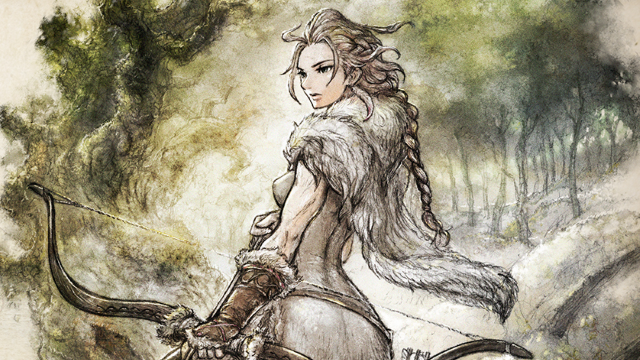





Published: Jul 20, 2018 06:38 pm